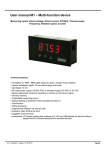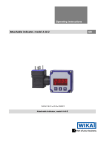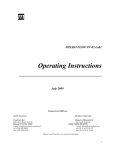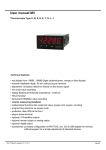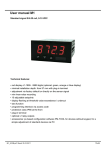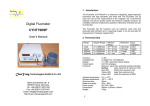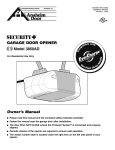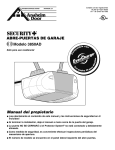Download User manual M1 – Multi-function device
Transcript
User manual M1 – Multi-function device Measuring inputs: Direct voltage, Direct current, Pt100(0), Thermocouple, Frequency, Rotation speed, Counter Technical features: • red display of -1999…9999 digits (optional: green, orange or blue display) • digit height 10 mm • display adjustment via factory presetting or directly on the sensor signal • min/max-memory • 5 adjustable supporting points • display flashing at threshold value exceedance/undercut • Tara-function • sliding averaging • two semiconductor switching points, galvanically not isolated • programming interlock via access code • protection class IP65 at the front • pluggable screw terminal • accessories: PC-based configuration software incl. CD and USB-adapter for devices without keypad and for a simple adjustment of standard devices. M1_7UGB.pdf update: 11.11.2014 48x24 Identification STANDARD-TYPES ORDER NUMBER Multi-function measuring inputs Housing size: 48x24 mm M1-7UR4A.000X.372AD Options – break-down order key: M 1- 7 U R 4 A. 0 0 0 X. 3 7 2 A D Standard type M-Line Operation D physical unit Installation depth 67 mm incl. plug-in terminal 1 Version A A Housing size 48x24x52 mm (WxHxD) 7 Switching points 2 2 semiconductor switching points Display type Multi-function measuring input U G Protection class 1 no keypad, operation via PC-software PM-TOOL 7 IP65 / plug-in terminal R Y B Voltage supply 3 9-28 VDC, galv. not isolated Display colours Green Red Orange Blue Number of digits 4-digit Measuring input Voltage, Current, Temperature, X Frequency 4 Digit height 10 mm A Analog output 0 without Interface without 0 Sensor supply 0 without Please state physical unit by order, e.g. mbar Contents 1. Brief description 3 2. Assembly 3 3. Electrical connection and connection examples 4 3.1. Terminal pin assignment 4 3.2. Connection examples 4 3.2.1. Voltage / Current 4 3.2.2. Pt100 / Pt1000 / Thermocouple 6 3.2.3. Frequency / Rotation speed 6 3.2.4. Counter 8 8 3.3. Switching points 8 Connection examples Description of function and operation 9 4.1. Operating and display elements 9 4.2. Programming software PM-TOOL 9 5. Setting-up the device 10 5.1. Switching on 10 6. Parameterisation 10 6.1. Selection of input signal, Type 10 4. 6.1.1. Voltage/Current, Volt, AMPE 11 Setting of the final and inital value, End, Enda, offs, offa 12 Setting of the decimal point, Dot.A 12 Zero point slowdown of the input signal, zero 12 Taring value, tara 12 Overflow/underflow behaviour, over 12 Input of supporting points for linearisation of the measuring signal, spc.A 12 6.1.2. Pt100, Pt1000, Thermocouple, pt.se, ther 13 Temperature device in °C/°F, unit 13 Impedance matching, offs 13 6.1.3. Pulse measuring, impu 14 6.1.3.1. Frequency, freq 14 Pulse triggering, i.typ 15 Range of frequency, rang 15 Filter, filt 15 Adjustment of final and initial value, end, endf, offs, offf 16 Adjustment of the decimal point, dot.F 16 Taring value, tara 16 Input of supporting points for linearisation of the measuring signal, spc.F 16 6.1.3.2. Rotation speed, turn 16 Pulse triggering, i.typ 17 Filter, filt 17 Pulse per revolution, ppt 17 Time base, time 17 Adjustment of the decimal point, dot 17 1 Contents 6.1.3.3. Counter upwards/downwards, Co.up, Co.dn 18 Pulse triggering, i.typ 18 Counter base / Input signal, co.ba 18 Wing, edge 18 Prescaler, pres 19 Display value and pulse final numerical value, end, end.c 19 19 6.2. General device parameter Adjustment of measuring time, sec 19 Adjustment of the sliding average value, glm 20 Presentation of initial/final value in the display, di.hi, di.lo 20 Allocation of functions onto the navigation keys, tast 20 Display flashing at threshold value exceedance/undercut, flas 20 20 6.3. Alarm parameter Limit value behaviour, a1.fu, a2.fu 21 Report of limit value errors, a1.er, A2.er 21 Switching behaviour of the outputs, a1.ty, A2.ty 21 Adjustment of the switching threshold, a1.li, a2.li 22 Adjustment of the hysteresis, a1.hy, a2.hy 22 Upper limit value, a1.lo, a2.lo 22 Lower limit value, a1.hi, a2.hi 22 Drop off delay, a1.of, a2.of 22 Activation delay, a1.on, a2.on 22 6.4. Safety parameter – locking of the parameterisation 7. 22 Assignment of individual numerical codes, Code 22 Activation/Deactivation of the programming interlock, run 22 22 Reset to default values Setting back the parameter onto delivery condition 8. Technical data 23 9. Safety advices 25 10. Error elimination 26 2 2. Assembly 1. Brief description 1. Brief description The panel instrument M1-7U is a 4-digit device for measuring of different kind of measuring signals such as direct voltage/direct current, temperature and frequency. The configuration happens via three front keys or via the optional PC-software PM-TOOL. An integrated programming interlock prevents unrequested changes of the parameter and can be released again via an individual code. Two integrated semiconductor switchpoints control limit values and report them to an superior master display. The electrical connection happens on the rear side via plug-in terminals. Selectable functions like e.g. the recall of the min/max-value, Tara-function, averaging, a direct change of the limit value in operating mode and additional measuring supporting points for linearisation complete the concept of a modern device. 2. Assembly Please read the Safety instructions on page 16 before installation and keep this user manual for future reference. 1. 2. 3. After removing the fixing elements, insert the device. Check the seal to make sure it fits securely. Click the fixing elements back into place and tighten the clamping screws by hand. Then use a screwdriver to tighten them another half a turn. CAUTION! The torque should not exceed 0.1 Nm! 3 3. Electrical connection 3. Electrical connection 3.1. Terminal pin assignment Type M1-7UR4B.000X.372AD – supply 9-28 VDC, galvanically not isolated Note: Terminals 3, 5 and 7 are electrically connected in the device. 3.2. Connection examples Below please find some connection examples, which demonstrate some practical applications: 3.2.1. Current / Voltage 2-wire sensor 4-20 mA 2-wire sensor 4-20 mA with external voltage source 4 3. Electrical connection 3-wire sensor 0/4-20 mA 3-wire sensor 0/4-20 mA with external voltage source 3-wire sensor 0-1/2…10 V 3-wire sensor 0-1/2…10 V with external voltage source 4-wire sensor 0-1/2…10 V, 50 mV 4-wire sensor 0-1/2…10 V, 50 mV with external voltage source 5 3. Electrical connection 3.2.2. Temperature Pt100 3-wire Pt1000 2-wire Thermocouple 3.2.3. Frequency / Rotation speed Encoder with TTL-output Encoder with external voltage source & TTL-output Encoder with PNP-output Encoder with external voltage source & PNP-output 6 3. Electrical connection Encoder with NPN-output Encoder with external voltage source and NPN-output Encoder with NPN-output and required external resistance Encoder with external voltage source, NPNoutput and required external resistance Encoder with PNP-output and external resistance circuit Encoder with external supply, PNP-output and external resistance circuit 7 3. Electrical connection 3.2.4. Counter If the device is used as counter, please use the connection examples for frequency/rotation speed and follow the examples given below for a performed reset input: Manual setting back via external feeler Automatic setting back via output 2 and manual setting back via external feeler 3.3. Switching points Connection examples NPN-output GND-switching PNP-output L+-switching Push-Pull-output UV and GND-switching 8 4. Description of function and operation 4. Description of function and operation 4.1. Operating and display elements The device comes with three keys, which are used for parameterisation of the device and whose deposited functions can be called up during operation. Functions, that can be adjusted or changed are always signalised by a flashing of the display. Adjustments that were made in the „Parameterisation-level“ are always confirmed with [P] and thus safed. The device safes however automatically all adjustments and changes back into operating mode, if no more key actuation takes place within 10 seconds. Key symbol Function in operating mode Function at parameterisation Program key [P] Change the parameterisation with program key [P]. Change into a lower parameterisation -level or to deposited values. Minus key [▼] Depending on adjusted key functions, use the minus-key [▼] for calling up the minvalue or changing a lower limit value. Change between parameter and changing of parameter within the value level. Plus key [▲] Depending on adjusted key functions, use the plus-key [▲] for calling up the minvalue or changing a lower limit value. Change between parameter and changing of parameter within the value level. A switched-on relay or an activated switching point will be reported optically by a flashing of the respective switching point LED next to the 7-segment display. A display over-/underflow is displayed by four bars „- - - -„. Example: Setting up the device parameter, e.g. selection of the input signal Parameter Choice Example: Setting up numerical values, e.g. final value of measuring range Numerical values are adjusted from the smallest to the highest digit with [▲] [▼] and confirmed digit per digit with [P]. A minus sign can only be adjusted on the leftmost digit. After the last digit, the display changes back into menu-level. 4.2. Programming via configuration software PM-TOOL MUSB4: The software comes on CD incl. an USB-cable with a device adapter. The connection is done via a 12-pole micromatch connector plug on the back and the PC is connected via an USB connector plug. System requirements: PC with USB interface Software: Windows XP, Windows Vista With this tool the device configuration can be created, skipped and safed on the PC. Via the easy to handle program surface the parameter can be changed, whereat the mode of operation and the possible selection options can be preset via the program. CAUTION! During parameterisation with connected measuring signal, make sure that the measuring signal has no mass supply to the programming plug. The programming adapter is galvanic not isolated and directly connected with the PC. Via polarity of the input signal, a current can discharge via the adapter and destroy the device as well as other connected components! 9 5. Setting up the device 6. Parameterisation 5. Setting up the device 5.1. Switching on Once the installation is complete, start the device by applying the voltage supply. Check beforehand once again that all the electrical connections are correct. Starting sequence For 1 second during the switching-on process, the segment test (8 8 8 8 8) is displayed, followed by an indication of the software type and, after that, also for 1 second, the software version. After the start-up sequence, the device switches to operation/display mode. 6. Parameterisation 6.1. Selection of the input signal: type During the type adjustment, an allocation of the input version takes place. Here, one can select between 5 input types: Voltage, Current, Pt100(0), Thermocouple and Pulse signal. Selection measuring signal Measuring signal special parameter Voltage s.page 12 Current s.page 12 Pt100(0) s.page 13 Thermocouple s.page 13 Pulse input General device parameter s.page 14-18 Measuring time, sliding averaging, presentation of initial and final value in the display, key function, display flashing See page 18 Alarm parameter Limit value behaviour, report limit value, switching behaviour, threshold, hysteresis, delay See page 19-21 Safety parameter Lock / release of parameterisation See page 21 10 6. Parameterisation 6.1.1. Device parameter for the allocation of voltage/current signals: VoLT, AMPE VoLT: 4 voltage signals are available: 0-10 V, 0-2 V, 0-1 V and 0-50 mV AMPE: Choose between the following signals: 0-20 mA and 4-20 mA Parameter Menu item Default Menu item Default VoLt AMPE Parameter End to OFFS to dot.A to EndA to OFFA to tArA to ZErO to OUEr SPC.A to dIS.1 to InP.1 to dIS.2 to InP.2 to dIS.3 to 11 6. Parameterisation Parameter Menu item Default InP.3 to dIS.4 to InP.4 to diS.5 to InP.5 to End / OFFS: Upper range value/lower range value By use of this pair of values, the desired display value can be allocated to the measuring signal. dot.A: Comma / decimal place Determine the decimal representation of the display value with the decimal point. It is used for the adjustment of the limit values, too. EndA / OFFA: Rescale the measuring input values With this function the final value/initial value can be rescaled to e.g. 19.5mA/3.2mA without application of the measuring signal. tArA: Setting up the Tara-/Offset value The preset value is added to the linearised value. So the characteristic line can be shifted by the selected amount. ZErO: Zero-point slowdown Here, a range of values around the zero-point can be preset, where the display shows a zero. If e.g. a 10 is adjusted, the display would show a zero within a range of value of -10 to +10 and continue below with -11 and above with +11. OVEr: Overflow and underflow behaviour The over-/underflow of the measuring input will be signaled by 4 horizontal bars at the top respectively by 4 bars at the bottom. Exception is input type „4-20“ (mA), where a measurand smaller than 1 mA can already be valuated as underflow. This shall indicate a sensor failure. no No additional check of the range takes place. By leaving the display range, the display remains on the smallest value „dI.Lo“ respectively highest value „dI.HI“. AdC At exceedance/undercut of the display range „dI.Lo“ / „dI.HI“ over-/underflow will be displayed. rAnG The measuring signal needs to be exactly in the preset measuring range „EnD“/“OFFS“, so that an overflow will not be detected. The display range and transformer range will be monitored additionally. 5 Pr The measuring signal is monitored over ± 5% of the adjusted measuring range. The display range will be monitored additionally. 10 Pr The measuring signal is monitored over ± 10% of the adjusted measuring range. The display range will be monitored additionally. SPC.A: Number of additional supporting points To linearise nonlinear sensor values, five additional supporting points can be defined for the initial and final value. Only the activated supporting point parameters are shown. dIS1…dIS5: Display values for supporting points Under this parameter supporting points are defined on a value basis. INP1…INP5: Analog values for supporting points The supporting points are always preset according to the selected input signal ma/V. Here, desired analog values can be freely adjusted in ascending order. 12 6. Parameterisation 6.1.2. Device parameter for the allocation of Pt100(0), Thermocouple: Pt.SE, THEr Pt.SE: Three types are available: Pt.Lo: Pt100 3-wire -50.0…200.0°C / -58.0…392.0°F Pt.Hi: Pt100 3-wire -200…850°C / -328…1562°F Pt.tH: Pt1000 2-wire -200…850°C / -328…1562°F tHEr: Select between: Thermocouple types L, J, K, B, S, N, E, T, R Parameter Menu item Default Menu item Default Menu item Default Pt.SE Parameter tHEr Parameter UnIt OFFS to to UnIt: Type of temperature metering Chose, if the temperature shall be displayed in °C or °F with UnIt. OFFS: Impedance matching The value alignment at a temperature measuring in °C can be adjusted between -20,0 and +20,0 and for a later measurement in °F between -36 and +36. If the measuring type is changed later, the value will be rounded. General device parameter see page 19 Alarm parameter see page 20 Safety parameter for lock / release of parameterisation see page 22 13 6. Parameterisation 6.1.3. Device parameter for the allocation of pulse signals: IMPU FrEq: Frequency measuring of TTL-signals, PNP-/NPN-sensors. tUrn: Rotation speed measurement (simplified adjustment option) of TTL-signals, PNP-/NPN-sensors. A flow rate can be scaled with this function, too. CO.up: Counter input (upwards) for TTL-signals, PNP-/NPN-sensors. CO.on: Counter input (downwards) for TTL-signals, PNP-/NPN-sensors. 6.1.3.1. Frequency measurement Parameter Menu item Default Menu item Default IMPu Parameter I.tYP rAnG FILt End to OFFS to dot.F to End.F to OFF.F to tArA to SPC.F to dIS.1 to InP.1 to dIS.2 to 14 6. Parameterisation Parameter Menu item Default InP.2 to dIS.3 to InP.3 to diS.4 to InP.4 to diS.5 to InP.5 to I.tYP: Pulse signal There a three modes for the triggering of the pulse input: ttL Active TTL-signals with approx. 0.8 V lower and approx. 2 V upper threshold. nPn Passive switching contact, which operates the internal pull-up depending on the rate. PnP Active sensor output. A pull-down is operated in the device. rAnG: Selection of the frequency range A selection of four frequency ranges is available: 9.999 0…9,999 Hz (automatic software filter on 100 Hz/5ms) 99.99 0…99,99 Hz (automatic software filter on 500 Hz/5ms) 999.9 0…999,9 Hz 9999 0…9999 Hz (approximate 10 kHz) FILt: Limitation of the pulse length For contact bounce suppression of mechanical contacts via selection of the filter frequency. no no particular evaluation of the pulse length 2 2 Hz with pulse-duty factor 1:1 => minimal pulse length 250 ms 5 5 Hz with pulse-duty factor 1:1 => minimal pulse length 100 ms 10 10 Hz with pulse-duty factor 1:1 => minimal pulse length 50 ms 20 20 Hz with pulse-duty factor 1:1 => minimal pulse length 25 ms 50 50 Hz with pulse-duty factor 1:1 => minimal pulse length 10 ms 100 100 Hz with pulse-duty factor 1:1 => minimal pulse length 5 ms 500 500 Hz with pulse-duty factor 1:1 => minimal pulse length 1 ms 15 6. Parameterisation End / OFFS: Upper range value/lower range value By use of this pair of values, the desired display value can be allocated to the measuring signal. dot.F: Comma / decimal place Determine the decimal representation of the display value with the decimal point. It is used for the adjustment of the limit values, too. End.F / OFF.F: Rescale the measuring input values With this function the final value/initial value ca be rescaled without application of the measuring signal. tArA: Setting up the Tara-/Offset value The preset value is added to the linearised value. So the characteristic line can be shifted by the selected amount. SPC.F: Number of additional supporting points To linearise nonlinear sensor values, five additional supporting points can be defined for the initial- and final value. Only the activated supporting point parameter are shown. dIS1…dIS5: Display values for supporting points Under this parameter supporting points are defined on a value basis. INP1…INP5: Analog values for supporting points The supporting points are always preset according to the selected input signal ma/V. Here, desired analog values can be freely adjusted in ascending order. 6.1.3.2. Rotation speed measurement As more than 80% of frequency measurement applications are referring to a rotation speed, there is a simplified adjustment mode available via type „Turn“. A flow rate can be scaled with this function, too. Parameter Menu item Default Menu item Default IMPu Parameter I.tYP FILt PPt to tIME dot to 16 6. Parameterisation I.tYP: Pulse signal There a three modes for the triggering of the pulse input: ttL Active TTL-signals with approx. 0.8 V lower and approx. 2 V upper threshold. nPn Passive switching contact, which operates the internal pull-up depending on the rate. PnP Active sensor output. A pull-down is operated in the device. FILt: Limitation of the pulse length For contact bounce suppression of mechanical contacts via selection of the filter frequency: no No particular evaluation of the pulse length 2 2 Hz with pulse-duty factor 1:1 => minimal pulse length 250 ms 5 5 Hz with pulse-duty factor factor 1:1 => minimal pulse length 100 ms 10 10 Hz with pulse-duty factor factor 1:1 => minimal pulse length 50 ms 20 20 Hz with pulse-duty factor 1:1 => minimal pulse length 25 ms 50 50 Hz with pulse-duty factor 1:1 => minimal pulse length 10 ms 100 100 Hz with pulse-duty factor 1:1 => minimal pulse length 5 ms 500 500 Hz with pulse-duty factor 1:1 => minimal pulse length 1 ms PPt: Pulse per turn With this parameter the number of pulse per turn can be entered directly. It generally works with sprockets and their number of sprockets, incremental encoder and their resolution or glands with a number of boreholes. For simple flow meter with impeller it is only neccessary to enter the number of pulse per liter or cubic metre. tIME: Time base In general the time base for rotation speed is always set on „MIn“, it can of course be changed into seconds or hours. dot: Comma / decimal place Determine the decimal representation of the display value with the decimal point. A rotation speed with up to 3 positions after decimal point can be displayed, if they are small enough. Example: Rotation speed measurement The rotation speed of a roller in a steel works needs to be displayed in turns/minute with one position after decimal place. The rotational speed will be recorded via a perforated disc with 18 holes, positioned in an angle of 20°. The maximum rotation speed of the roller is 60 turns/minute. Like this, adjust for example FILt = 100; PPt = 18; tIME = MIn; dot = 0.0. The difficulty with the adjustment of the filter is to calculate the pulse length precisely. 17 6. Parameterisation 6.1.3.3. Upwards/downwards counter Parameter Menu item Default Menu item Default IMPu Parameter In.tY Co.bA EdGE PrES to FILt End to End.C to dot to I.tYP: Pulse signal There a three modes for the triggering of the pulse input: ttL Active TTL-signals with approx. 0.8 V lower and approx. 2 V upper threshold. nPn Passive switching contact, which operates the internal pull-up depending on the rate. PnP Active sensor output. A pull-down is operated in the device. Co.bA: Counter base As standard the device records incoming pulses during counter operation. However the counter basis can also be used as system time in seconds or minutes. In doing so the pulse input turns into gate time, it counts at wing PoSI (HIGH-signal) and stands at LOW. The logic is contrary at wing nEGA. EdGE: Counting start / counting end (wing) The active wing declares when the counting takes place. The pulse recording PuLS is choosen as counter basis, via this it will be declared if the internal counter will be increased by the positive wing PoSI or the negative wing nEGA. If time is taken as time basis, then the active-triggering/HIGH-triggering will be selected with PoSI and the passive triggering/LOW-triggering will be selected with nEGA. The counter reset is always statical. 18 6. Parameterisation PrES: Prescaler A prescaling in the device happens via the prescaler, so even large pulse numbers like e.g. 5.000.000 can be recorded by the device. Only the prescaled value will be included for the scaling. FILt: Limitation of the pulse length For contact bounce suppression of mechanical contacts via selection of the filter frequency: No particular evaluation of the pulse length no 2 2 Hz with pulse-duty factor 1:1 => minimal pulse length 250 ms 5 5 Hz with pulse-duty factor factor 1:1 => minimal pulse length 100 ms 10 10 Hz with pulse-duty factor factor 1:1 => minimal pulse length 50 ms 20 20 Hz with pulse-duty factor 1:1 => minimal pulse length 25 ms 50 50 Hz with pulse-duty factor 1:1 => minimal pulse length 10 ms 100 100 Hz with pulse-duty factor 1:1 => minimal pulse length 5 ms 500 500 Hz with pulse-duty factor 1:1 => minimal pulse length 1 ms End, End.C: Display terminal value and pulse terminal value The display value can be freely linearised via the prescaled pulse number. For it the number of desired pulses will be allocated to a display value. The zero-point cannot be prescaled. At a backwards counter End and End.C serve as start value. For the absolute counter threshold values, the adjustments of dI.HI and dI.Lo are used. By reaching them, all digits that reached this value are flashing, what equates an underflow/overflow. General device parameter see page 19 Alarm parameter see page 20 Safety parameter for lock / release of parameterisation see page 22 6.2. General device parameter Parameter Menu item Default SEC to GLM to dI.HI to dI.Lo to tASt FLAS SEC: Measuring time Adjustement of basis measuring time respectively of the frequency filter for a relief of the measurand. This filter value is adjustable from 0.01…2.00 seconds. At pulse measurements the value can be selected up to 0.00, so that the identification runs on maximum speed. 19 6. Parameterisation GLM: Sliding averaging Besides the measuring time, as sliding averaging of 1…20 values can be activated, too. Here, no seperate emphasis between the past values is taking place. At GLM = 1 the sliding averaging is switched off. dI.Lo, dI.HI: Presentation of start/terminal value in the display For overflow evaluation the measuring range and the optional selected overflow (OVEr) behaviour are evaluated. In addition this range can be limited by the parameter dI.HI and dI.Lo. tASt: Allocation (deposit) of key functions For operating mode either a min/max-value monitoring or a limit value correction on the navigation keys can be deposited here. If the min/max memory is activated by EHtr, the measured min/max-values will be safed during operation and can be recalled via the navigation keys [▲] [▼]. At restart of the device, all values are lost. If the limit value correction AL.LI is selected, limit values can be changed during operation, without interfere with the operating procedure. If no is adjusted, the navigation keys [▲] [▼] are without any function in the operating mode. FLAS: Display flashing at threshold value exceedance/undercut A display flashing can be added as additional alarm function either to the first limit value (select: AL-1), to the second limit value (select: AL-2) or to both limit values (select: AL-12). With no (factory settings), no flashing is allocated. 6.3. Alarm parameter Parameter Menu item Default AI.Fu AI.Er AI.tY AI.LI to AI.HY to AI.HI to AI.Lo to AI.oF to AI.on to A2.Fu A2.Er 20 6. Parameterisation Parameter Menu item Default A2.tY A2.LI to A2.HY to A2.HI to A2.Lo to A2.oF to A2.on to A1.Fu, A2.Fu: Limit value behaviour Change between the different working types of switching outputs by using the functional principle. If Ax.Fu = oFF was selected, the relevant switching point parameter will not be displayed. oFF The switching point is without function and relevant parameter will not be displayed (Default status). On The switching point is switched on during measuring operation and corresponding parameter (except Ax.Er and Ax.tY) will not be displayed. HI-LI Switch at threshold value exceedance. Lo.LI Switch at threshold value undercut. rAnG Switch within the preset range. Out.r Switch outside the preset range. A1.Er, A2.Er: Report at threshold value errors If a check sum should not be correct or the range of value is affected, the switching point behaviour can be preset. on Selected switching point behaviour is activated. HIGH/L+ is switched in push-pull-mode. oFF The switching points behave contrary. The maloperation transcribes the actual threshold function in case of an occured error. no An error has no defined influence. This means a value of 10,000 regarding the overflow evaluation and a value of -2,000 for the underflow evaluation. A1.tY, A2.tY: Switching behaviour of the outputs Depending on connection and operating mode the switching outputs do support and work inverted. This means under alarm condition the switching outputs will be deactivated. Thus the alarm condition remains in case of a device failure. nPn The output is switched actively to GND without alarm condition. PnP PnP is switched actively to the voltage supply (rectified, filtered internal device supply) without alarm condition. Ac.HI The output is switched to HIGH / voltage supply without alarm condition. Ac.LO The output is switched to LOW / GND without alarm condition. 21 7. Reset to default values (factory settings) A1.L1, A2.L1: Threshold level Here the threshold level is defined that activates/deactivates an alarm. This parameter will not be recalled if the window function is used. A1.HY, A2.HY: Hysteresis The hysteresis defines a difference to the limit value which defines the delay of an alarm. This parameter will not be recalled if the window function is used. A1.HI, A2.HI: Upper limit value A1.Lo, A2.Lo: Lower limit value For range functions A1.FU, A2.FU = rAnG or Out.r this value defines the upper/lower limit of the window function between „-1999…9999“. This parameter will not be displayed with other functional principles. The functional principle can change between switching point 1 and 2. A1.oF, A2.oF: Dropout delay Preset a delayed switching off of 0-5999 seconds for the limit values. The time value will not be safed permanently and is set back by restart of the device. Furthermore the alarm condition will be detected during restart, without considering the preset delay. A1.on, A2.on: On-delay Preset a delayed switching on of 0-5999 seconds for the limit values. The time value will not be safed permanently and is set back by restart of the device. Furthermore the alarm condition will be detected during restart, without considering the preset delay. 6.4. Safety parameter for lock/release of parameterisation Parameter Menu item CodE Default to run CodE: Assignment of an individual numerical code (4-digit number combination, free allocatable) With assignment of this code (0000 factory settings), all parameter will be locked for the user, if LOC was selected afterwards under menu item run. By pushing [P] in operating mode for approx 3 seconds, the message CodE appears in the display. The code needs to be entered before each parameterisation, until the programming is released with ULoC under run. run: Activation/Deactivation of programming interlock Select with [▲] [▼] between deactivated key lock ULOC (factory settings) and activated key lock LOC. The keypad is locked, if LOC was selected. To get into menu level again, [P] needs to be pushed for 3 seconds in operating mode. The now appearing CodE (factory settings 0000) needs to be entered with [▲] [▼] and [P] and releases the keypad. A faulty entry will be displayed with FAIL. In LOC-mode the device cannot be resetted, which shall additionally secure the regular operation. 7. Reset to default values (factory settings) To set the device into a defined inital state, there is the possibility to do a reset to the default values. Please proceed as follows: Switch off the voltage supply of the device. Push the [P]-key and switch voltage supply on with in-position [P]key. Push the [P]-key until „----“ appears in the display. Due to the reset, default values are charged and used for further operation. The device is now reset to the delivery state. ATTENTION! All application related data are lost! 22 8. Technical data 8. Technical data Housing Dimensions 48x24x52 mm (WxHxD) 48x24x67 mm (WxHxD) including plug-in terminal Panel cut-out 45.0+0.6 x 22.2+0.3 mm Wall thickness up to 5 mm Fixing screw lements Material PC Polycarbonate, black, UL94V-0 Sealing material EPDM, 65 Shore, black Protection class standard IP65 (front panel), IP00 (back side) Weight approx. 100 g Connection plug-in terminal; wire cross-section up to 1.5 mm2 Display Digit height 10 mm Segment colour red (optional green, orange or blue) Display range -1999 to 9999 Switching points LED S1, LED S2 Overflow horizontal bars at the top Underflow horizontal bars at the bottom Display time 0.1 to 10.0 seconds Signal Measuring range Measuring span Resolution Internal resistance Voltage 0…10 V 0…12 V ≥ 14 bit Ri > 100 kΩ Voltage 0…2 V 0…2.2 V ≥ 14 bit Ri ≥ 10 kΩ Voltage 0…1 V 0…1.1 V ≥ 14 bit Ri ≥ 10 kΩ Voltage 0…50 mV 0…55 mV Ri ≥ 10 kΩ Current 4…20 mA 1…22 mA Ri = ~125 Ω Current 0…20 mA 0…22 mA Ri = ~125 Ω Pt100-3-wire -50…200°C -58…392°F 0.1°C / 0.1°F Pt100-3-wire -200…850°C -328…1562°F 1°C / 1°F Pt1000-2-wire -200…850°C -328…1562°F 1°C / 1°F Thermo K -270…1350°C -454…2462°F 1°C / 1°F Thermo S -50…1750°C -328…3182°F 1°C / 1°F Thermo N -270…1300°C -454…2372°F 1°C / 1°F Thermo J -170…950°C -274…1742°F 1°C / 1°F Thermo T -270…400°C -454…752°F 1°C / 1°F Thermo R -50…1768°C -58…3214°F 1°C / 1°F Thermo B 80…1820°C 176…3308°F 1°C / 1°F 23 8. Technical data Signal Measusing range Measuring span Resolution Thermo E -270…1000°C -454…1832°F 1°C / 1°F Thermo L -200…900°C -328…1652°F 1°C / 1°F Frequency 0…10 kHz 0…10 kHz 0,001 Hz NPN 0…3 kHz 0…3 kHz 0,001 Hz PNP 0…1 kHz 0…1 kHz 0,001 Hz Rotation speed 0…9999 1/min 0…9999 1/min 0,001 1/min Counter 0…9999 (Prescaler up to 1000) Pulse input TTL HTL/PNP NPN Namur Low <2 V, High >3 V Low <6 V, High >8 V Low <0.8 V, High via resistance Low <1.5 mA, High >2.5 mA Reset-input active <0.8 V Measuring error Standard 0.2% of measuring range ± 1 digit Pt100/Pt1000 0.5% of measuring range ± 1 digit Thermocouple 0.3% of measuring range ± 1 digit Accuracy Reference junction ± 1°C Drift of temperature 100 ppm / K Measuring time 0.01…20.0 seconds Sampling rate approx. 1/s at thermocouple, approx. 100/s at standard signals Measuring principle U/F-conversion Resolution approx. 14 bit at 1s measuring time Output 2 solid-state outputs, galvanically not isolated Low-side: max. 28 V, 100 mA (NPN; mass switching) High-side: UV–3V, 100 mA (PNP, +UV-switching) Push-pull: Changeover between mass GND and auxiliary energy +UV Interface Configuration interface for PC-software PM-TOOL with USB-dongle Power supply 9-28 VDC galvanically not isolated, ≤ 1VA Memory EEPROM Data life ≥ 100 years at 25°C Ambient condition Working temperature -20°C…+50°C Storing temperature -30°C…+70°C Weathering resistance relative humidity 0-85% on years average without dew EMV EN 61326 CE-identification Conformity according to directive 2004/108/EG Safety standard According to low voltage directive 2006/95/EG EN 61010; EN 60664-1 24 9. Safety advice 9. Safety advice Please read the following safety advice and the assembly chapter 2 before installation and keep it for future reference. Proper use The M1-7U-device is designed for the evaluation and display of sensor signals. Danger! Careless use or improper operation can result in personal injury and/or damage the equipment. Control of the device The panel meters are checked before dispatch and sent out in perfect condition. Should there be any visible damage, we recommend close examination of the packaging. Please inform the supplier immediately of any damage. Installation The M1-7U-device must be installed by a suitably qualified specialist (e.g. with a qualification in industrial electronics). Notes on installation • There must be no magnetic or electric fields in the vicinity of the device, e.g. due to transformers, mobile phones or electrostatic discharge. • The fuse rating of the supply voltage should not exceed a value of 6A N.B. fuse. • Do not install inductive consumers (relays, solenoid valves etc.) near the device and suppress any interference with the aid of RC spark extinguishing combinations or free-wheeling diodes. • Keep input, output and supply lines separate from each other and do not lay them parallel with each other. Position “go” and “return lines” next to one another. Where possible use twisted pair. So, the best measuring results can be received. • Screen off and twist sensor lines. Do not lay current-carrying lines in the vicinity. Connect the screening on one side on a suitable potential equaliser (normally signal ground). • The device is not suitable for installation in areas where there is a risk of explosion. • Any electrical connection deviating from the connection diagram can endanger human life and/or can destroy the equipment. • The terminal area of the devices is part of the service. Here electrostatic discharge needs to be avoided. Attention! High voltages can cause dangerous body currents. • Galvanically isolated potentials within one complex need to be placed on an appropriate point (normally earth or machines ground). So, a lower disturbance sensibility against impacted energy can be reached and dangerous potentials, that can occur on long lines or due to faulty wiring, can be avoided. 25 10. Error elimination 10. Error elimination Error description Measures 1. The unit permanently indicates overflow. • The input has a very high measurement, check the measuring circuit. • The display range of 999 respectively the preset measuring range was exceeded, control the supporting points respectively the selected input type and signal range. Not all of the activated supporting points are parameterised. Check if the relevant parameters are adjusted correctly. 2. The unit permanently shows underflow. • The input has a very low measurement, check the measuring circuit. • The display range of -1999 respectively the preset measuring range was undercut, control the adjustments. • Not all of the activated supporting points are parameterised. Check if the relevant parameters are adjusted correctly. 3. The device shows „Lbr“ in the 7-segment display. • Check if the selected input type is correct. Only temperature measurments and 4…20 mA show these kind of error indication. • Check the wiring regarding a contact and correct connection. 4. The device shows „HELP“ in the 7-segment display. • The device has detected an error in the configuration memory, operate a reset to default values and configurate the device according to your application. 5. Parameter for the parameterisation of the input are not available. • The programming interlock is activated. • Enter correct code. 6. The device shows „Err1“ in the 7-segment display. • Contact the manufacturer if errors of this kind occur. 7. The device does not react as expected. • If you are not sure, if the device has been parameterised before, restore the delivery state as described in chapter 7. 8. There are higher constant errors of indication at thermocouple measurement. • Remove strong heat or cold sources from the direct surroundings of the device. • Reduce the contact rating of the relay switching points onto preferably under 10 mA, as higher switching current lead to an increased local warming and thus to a massive error at the reference junction measurement. • If the variations during operation are permanent and constant, the reference junction measurement can be corrected via the offset. M1_7UGB.pdf 26 Update: 11.11.2014




























